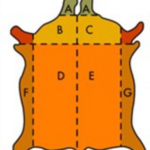You can easily turn a drab room into one of elegance and interest by using a textured paint effect. This technique also works wonders for hiding imperfect walls. Textured paints are fantastic ways to hide problem walls without having to actually put a new wall up. Below, you will find a number of techniques for a variety of looks that you may want to achieve.
Start by properly fixing any repairs that need to be made and then prime and paint your walls as discussed in my article “How to Repair Walls and Paint”. Always start with clean and painted walls. Be sure the color on the walls is solid without streaks and that there is no see through primer. If need be, paint the wall a second time to ensure even color coating.
Mixing the glaze/color mixture:
Sponging on: Once your base coat is dry, mix the color you are going to be sponging on with the glazing liquid in one part paint to four parts glaze. Use a paint measuring cup to ensure even measurements. I mix my paint and glaze right into a large sized measuring cup and use this to dip my sponge into. It is easy to hold and saves on clean up. Plus, when the color is low, you can easily add more. Just be sure to use the same ratio of glaze and color each time you need more glaze-color mix for the walls, otherwise you will end up with uneven application of color across your walls. These can be purchased for less than a dollar at a DIY store. The more glaze, the longer it will take to dry, which could be good if you have not done this before and/or want a longer working time with the paint. You can mix different ratios of paint and glaze and apply to a piece of scrap drywall to see what effects can be achieved.
I typically use a lighter color as my base coat and then select a darker color paint to use with the glaze. You can certainly elect to have a darker base coat and a lighter paint as the texture color for a different effect. More of the base coat will be visible in this way. Depending on the look you want to achieve in your room, select colors that will result in the desired effect. See my article “How to Select Paint and Colors”.
Using a damp (not soaking wet) sea sponge (also purchased at a DIY store), dip one side into the glaze mixture and then dab the wall with the sponge. Be sure to turn your wrist and hand between application to ensure no repeating patterns occur or the end effect will end up looking odd. Work across the room and not up and down. Periodically, blot the sponge on a rag to keep the holes from filling with too much paint to keep a blotted pattern from occurring. Occasionally dip the sponge in clean water and wring it out well before applying the glaze color to it. Be sure to always use the same side of the sponge to ensure an even pattern. Step back between applications to inspect your work and blot any areas that may have too heavy blots or apply more glaze mix to those that are lighter in color or that you have missed. For corners, use a small piece of sponge to apply color.
Sponging off: With this technique you are going to apply the base coat to the wall and subtract the color with a sponge, rather than add color as in sponging on. This technique will achieve a more delicate look than in sponging on, which has a more visible pattern. Apply a base coat (color of your choice) and after it has dried, with a roller, roll on the glaze mixture (paint and glaze). With a clean, damp sea sponge, blot the wet glaze mixture to remove the paint. You should alternate your hand and wrist to avoid repetitive patterns. Continue rolling on glaze mixture and removing it with the sponge until the wall is complete. You can mist the glaze with water if it begins to dry before you are done.
Alternatively, (although I prefer the hand method) you can purchase a sponge roller attachment that easily attaches to your extension pole for those hard to reach places such as over stairwells or if you want to use this on ceilings. I recommend alternating direction as the rollers have a space between the sponge head. So, start by rolling the paint mixture (or removing the glaze paint if doing sponging off) in an up and down motion and then go back and cover the space with a left to right motion.
Ragging on: This technique will give you a rippled look. You can do this a number of ways. You can wrap a damp rag onto a paint roller with rubber bands and work the roller/rag across the walls. The rag should be wrinkled-looking to create the ragging on effect. Or, by hand, you can simply roll the rag up long ways into a cylinder of sorts and by hand, roll it across the walls. Again, the rag will be wrinkled. Use an old cotton t-shirt, cheesecloth or rags sold in a hardware or DIY store. Be sure whatever you use that it is lint-free, otherwise you will end up with lint on your walls. Cover the walls with your basecoat and then dip your rolled rag/roller into the glaze/paint mixture and roll onto the wall surface. You should roll the paint onto the wall at a slight angle so that you don’t end up with odd looking straight columns.
Ragging off: This technique, similar to sponging off is a subtractive one. Use the same materials you would as in ragging on, but this time after you roll the glaze/paint mixture onto the walls with a (regular) roller, you are going to roll the rag upwards, starting at the bottom of the wall and working your way up in two foot sections (so the glaze color does not dry). You can simply turn the rag inside out and re-roll it when it becomes filled with paint and then use a new rag once the other side is saturated with color. The rag does not need to be damp to do ragging off.
Sand-textured paint: This look will be similar to a stucco effect. For this textured effect, prime your walls or ceiling as usual. Then, using a large 5 gallon bucket, pour the textured paint into it. Make it easy on yourself and purchase (for only a couple of bucks) a roller grid that you can place at an angle inside the bucket. This looks like a silver rectangular plate cheese grater of sorts (but it does not grate anything). This will make paint application much easier on you and help with even application of the paint onto the walls. You will need a looped roller for this job. Do not use a regular roller as you will not get the stucco effect. The looped roller has small wiry loops rather than the regular nylon covering on a roller.
Then, after dipping the roller into the textured paint, run it over the roller grid (inside the bucket) and glide it over the walls. You can go over the same area you have already rolled the texture onto if you would like more coverage but remember, go easy rather than heavy as you can always go over it again later. If you decide the paint is too heavy, you will have a headache trying to get all the stucco off with paint remover. After you have covered your walls with the textured paint, allow it to dry several hours and then prime and paint the walls the color of your choice.
Using a textured paint may seem scary to you, but it really is a simple way to improve your walls and room with very little money. Practice your technique on a scrap of drywall until you feel comfortable and then try your hand on the actual wall. Remember, if you mess up, you can easily paint over most textured paints and start again. If you decide you do not like the textured look, again, you can simply paint over the wall. You will be very surprised by how easily you can add beauty to an ugly room or cover imperfect, old walls with a little work, time and money.
Home Depot has a wonderful video for about five dollars that illustrates how to do each of these techniques and more. I highly recommend purchasing one if you are interested in trying out a textured paint.





